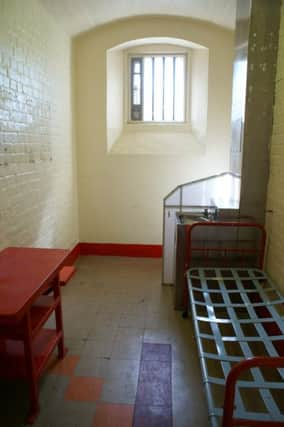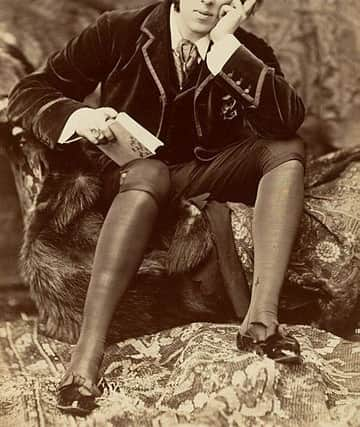Oscar Wilde's gaol open to the public for two-month event inspired by his writings


For the first time in its history the 170-year-old institution, formerly known as Reading Gaol, was opened to the public.
Until the end of October people from all over the world will be flocking inside the ominous, cruciform-shaped penitentiary to sample an extraordinary menu of works by leading artists, performers and writers.
Advertisement
Hide AdAdvertisement
Hide AdIn celebration of the prison’s most famous inmate - Oscar Wilde - an arts organisation called Artangel has put together the two-month event entitled “Inside - Artists and Writers in Reading Prison.”


News Letter readers will need no introduction to Wilde, the iconic Irish writer and bohemian who went to Portora Royal School in Enniskillen between 1864 and 1871 and to Reading Gaol between 1895 to 1897.
As an old-Portoran myself, fuelled by a life-long enthusiasm for Wilde’s writings and accelerated by a fast train from London last Thursday morning, my name was the first one in Reading Prison’s visitors’ book!
In contrast, Oscar signed his famous Ballad of Reading Gaol only with his prison number - C.3.3 - when he wrote the poem after his release.
“I never saw a man who looked


With such a wistful eye
Upon that little tent of blue
Which prisoners call the sky.”
Advertisement
Hide AdAdvertisement
Hide AdSince my first morning in Portora’s assembly hall in 1960, sitting beneath Oscar’s brightly-painted name on the faded memorial to famous old-boys (his name was deleted when he was imprisoned, and repainted in later years) I’ve often thought of his cell window’s inaccessible fragment of freedom.
After climbing the steep, narrow, iron stairs in C-Wing, on the first floor landing, past a dozen identical, red-painted doors, I found the eye-level cardboard label for cell C.2.2.
(In Oscar’s day it was cell C.3.3, before an administrative reallocation of cell numbers changed it to today’s C.2.2.)
Inside was a table, an iron bed, a toilet, a sink and a high-level window secured with thick, iron bars.
Advertisement
Hide AdAdvertisement
Hide AdSadly, the harsh glare of September sunshine extinguished Oscar’s “tent of blue” but not the bleak reality of his confinement.
Wilde was completely alone for 23 hours a day.
He was allowed out only to walk in an exercise wheel or to attend chapel.
He was forced to wear a hood over his head when out of his cell, preventing eye contact with other inmates.
Talking to other inmates was strictly forbidden.
Initially he had no books or writing paper.
It was here that Oscar spent two years imprisoned for “acts of gross indecency with another male person”.
Advertisement
Hide AdAdvertisement
Hide Ad“His gilded life was over” said Artangel’s James Lingwood, “he was no longer a famous name - just a number!”
James and colleague Michael Morris, co-directors of Artangel, described the strict, demeaning, penal system that “broke Oscar.”
The body-search, the mug shots, the body measurements, the uncomfortable prison clothes, the relentless, repetitive, mundane, forced labour and the grinding, dehumanising, solitary confinement.
“One of a thousand lifeless numbers, as of a thousand lifeless lives,” Oscar penned in De Profundis.
Advertisement
Hide AdAdvertisement
Hide Ad“The prison architecture today is more or less intact,” said Michael Morris, standing beside the original door from Oscar’s cell, which is now on a plinth in the Prison Chapel, one of the must-see art works.
Oscar languished behind the impenetrably thick door for two years, after a while allowed only a few books and several sheets of writing paper a day.”
“He had to give the prison governor what he’d written of De Profundis each day,” said James Lingwood.
The Artangel organisation’s whole programme is inspired by Wilde’s writings and by the penitentiary where he penned De Profundis (Out of the Depths) the extended letter to his lover Lord Alfred Douglas.
Advertisement
Hide AdAdvertisement
Hide AdAs part of Artangel’s event nine contemporary writers’ letters are exhibited, written from personal experience of imprisonment. One, by Danny Morrison, imagines a final letter from IRA commander and WWI soldier Reginald Dunn, before he was hanged in Wandsworth Prison in 1922.
Each Sunday in Reading Prison’s chapel, different artists, writers or performers - from Ralph Fiennes to Maxine Peak and Patti Smith - are reading De Profundis in its entirety.
The four-hour readings of the 100-page letter (a copy is also exhibited) will be streamed on the internet and re-played between performances.
The exhibition forms part of Reading 2016, a programme of events marking Reading’s Year of Culture, and the National Trust is running guided tours of the prison throughout the show’s duration.
Advertisement
Hide AdAdvertisement
Hide AdAs I left the jail I told James Lingwood that I was an old-Portoran and that Wilde’s writings have been a life-long inspiration.
“Yes, he speaks to every generation,” said James.
“That night the empty corridors
Were full of forms of Fear,
And up and down the iron town
Stole feet we could not hear,
And through the bars that hide the stars
White faces seemed to peer.”
For details, ticket prices and prison opening hours see
www.readingarts.com